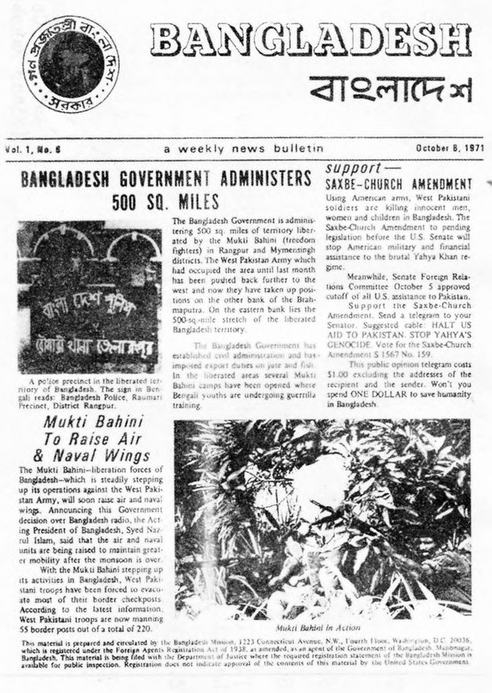Jyoti Rahman

Couple of years ago, I noted how the typical discourse on Ziaur Rahman is full of lies. An (Awami League supporting) old friend asked me to write a positive account of Zia’s politics: instead of rebutting X, write about Y, he told me-. This (painfully slowly progressing) series is an attempt at that. Meanwhile, a regular reader asked me to write about Zia’s role during the war — not to refute the preposterous propaganda about him being a Pakistani spy, but about what Zia actually did after the radio declarations of March.
Interestingly, not much is readily available on the matter. While it is well known that Major Abu Taher or Major Khaled Mosharraf were injured in the battles of Kamalpur and Kasba respectively until recently I couldn’t even name a battle Zia was associated with. According to Muyeedul Hassan’s Muldhara ’71 (among other sources), Zia wanted Osmani to establish a war council. I have also heard from a number of freedom fighters that Zia worked hard to build a regular army. But these weren’t exactly the stuff of ‘battlefield valor’.
This well-researched post by দাসত্ব, a Bangla blogger, shows that Zia was actually quite intricately involved with a number of battles in 1971. I highlight some key points from the post over the fold. All the photos are from his post as well.
Z-Force created
In early June, the Mujibnagar government decided to raise a regular infantry brigade to fight the Pakistani occupation forces in formal set piece battles. Major Ziaur Rahman was chosen to command this brigade. Handing over the command of Sector 1 (covering greater Chittagong) to Captain Rafiq, Zia moved to Teldhala, which is in the Garo Hills, on the border of Bangladesh and Meghalaya. He was accompanied by Captain Oli Ahmed and Captain Sadeq. Within a few days, Major AZM Aminul Huq moved to Teldhala from Ramgarh (Chittagong) with the 8th Bengal (Zia’s regiment when the war began). On 17 June, Major Shafayat Jamil joined them from Rayganj (West Dinajpur, India) with his 3rd Bengal. Captain Hafizuddin arrived from Bangaon with the 1st Bengal on 25 June. In addition, Major Moinul Hossain Chowdhury moved from Calcutta.
On 7 July, the first infantry brigade of Bangladesh army was formed by integrating three battalions — the 1st, 3rd, and 8th — of the East Bengal Regiment. The brigade was renamed Z-Force in September, after its commander Major Zia.
The first battle of Kamalpur
Kamalpur had strategic importance because it was on the road connecting Jamalpur, Tangail and Dhaka. Any eventual march to Dhaka would have required control of this post. Accordingly, Pakistani defence in the post was very strong. In addition to 20 hit-and-run attacks, there were four set-piece battles here, on 31 July, 22 October, 14 November, and 24 November. In the third battle, Major Taher lost his leg. There were 197 KIA on the Bangladeshi side here, while 220 Pakistanis (including a major) were killed. And yet, Kamalpur wasn’t liberated until 4 December, when the Indians joined the war.
In the third week of July, Zia asked Major Moin (then commanding the 1st Bengal) to hit the Kamalpur border post. Major Moin opined that his troops were not capable of winning in a set-piece battle. Zia overruled Moin’s suggestion of a guerrilla attack. And the first battle was set in motion.
Major General Jamshid’s 36 Ad Hoc Division was in charge of defending the Pakistani occupation of greater Mymensingh. The Kamalpur-Jamalpur route to Dhaka was defended by Brigadier Qadir’s 93 Brigade, which comprised two regiments — 33 Punjab and 31 Baluch. The 31 Baluch was in charge of defending Kamalpur, Nakshi and Baromari. They were assisted by East Pakistan Civil Armed Force and razakars. Captain Ahsan Malik commanded the Kamalpur post, which had three 81mm mortars.
Against this, the total strength of Major Moin’s 1st Bengal was 850.
Zia himself was present to coordinate the first battle of his brigade. Around 3 am on 31 July, Zia and Moin took a position with the 1st Bengal about 1100-1200 yards from the Pakistani base. According to the plan, Captain Mahbub was behind the enemy base, Captain Hafiz and Captain Salahuddin were 600 yards inside the enemy line, Major Moin and Flight Lieutenant Liaquat were in the nearby jute field, while Zia was on a hillock with light canon and heavy machine gun. There was a cut-off party which mined the Kamalpur-Buksheegunj road.
By 3.30am, Captain Salahuddin Mamtaz entered the enemy base with his two platoons. Pakistanis retreated inside the bunker, and there were hand-to-hand combat. Captain Salahuddin was killed by machine gun fire in the post’s community centre — he would be posthumously awarded Bir Uttam.
Upon hearing about Salahuddin Mamtaz’s death, Moin commanded Captain Mahbub to attack from the rear. As Mahbub didn’t respond, Moin moved out in the open for better wireless reception. He was hit by enemy fire, his wireless operator was killed and the set was damaged. By then, daylight had broken and the attack appeared to have failed. Zia, Moin and Liaquat led the rescue effort amid enemy fire.
Meanwhile, enemy reinforcement of three truckload of troops and two 120 mm mortars were hit by mines on the road from Buksheegunj.
A total of 35 freedom fighters were killed in the battle, against 50 or so Pakistanis. While Kamalpur remained in Pakistani hand, the enemy morale was hit hard. General Sam Manekshaw visited the Z-Force head quarters to praise the Bangladeshis.
Battle of Nakshi
Around 3.45am on 3 August, 8th Bengal hit the Pakistani border post of Nakshi (in Sherpur). The freedom fighters got to around 50 yards of the post, but failed in the face of Pakistani mortars and mines. Captain Amin Ahammed and Lieutenant Modasser led the assault while Major Aminul Huq (the battalion commander) provided the firing cover. Zia coordinated the battle himself. Captain Amin was hit by enemy fire, and Major Aminul Huq saved him while risking his own life.
Liberated Roumari

On 6 August, Zia charged Lt Nurunnabi of the 3rd Bengal to create a defence perimeter around the liberated area of Roumari. Nurunnabi created a citizen’s committee on 8 August. On 11 August, Zia visited the area with the Indian Major General Gulbat Singh Gill. Eventually, a hospice, a customs office, a post office, a police station, and a training centre for the freedom fighters were opened in Roumari. Zia deposited 100,000 takas raised in revenue from Roumari to the Mujibanagar government during the war.
This photo of Major Zia, Major Shafayat Jamil, and Indian Brigadier Sabid Singh, was taken in front of the Roumari High School.

(Cross-posted in Mukti)
